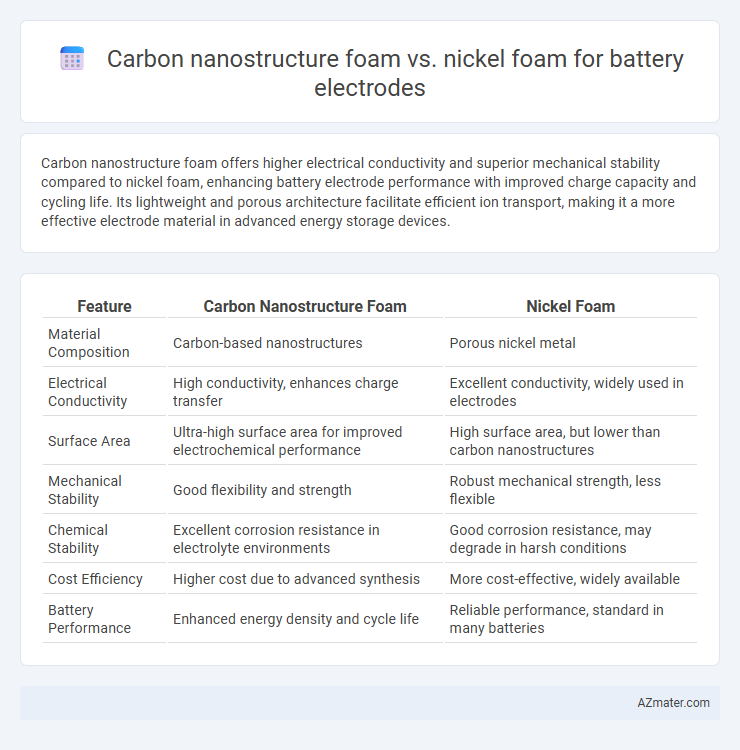Carbon nanostructure foam offers higher electrical conductivity and superior mechanical stability compared to nickel foam, enhancing battery electrode performance with improved charge capacity and cycling life. Its lightweight and porous architecture facilitate efficient ion transport, making it a more effective electrode material in advanced energy storage devices.
Table of Comparison
| Feature | Carbon Nanostructure Foam | Nickel Foam |
|---|---|---|
| Material Composition | Carbon-based nanostructures | Porous nickel metal |
| Electrical Conductivity | High conductivity, enhances charge transfer | Excellent conductivity, widely used in electrodes |
| Surface Area | Ultra-high surface area for improved electrochemical performance | High surface area, but lower than carbon nanostructures |
| Mechanical Stability | Good flexibility and strength | Robust mechanical strength, less flexible |
| Chemical Stability | Excellent corrosion resistance in electrolyte environments | Good corrosion resistance, may degrade in harsh conditions |
| Cost Efficiency | Higher cost due to advanced synthesis | More cost-effective, widely available |
| Battery Performance | Enhanced energy density and cycle life | Reliable performance, standard in many batteries |
Introduction to Battery Electrode Materials
Carbon nanostructure foam offers high electrical conductivity, large specific surface area, and excellent chemical stability, making it an ideal candidate for battery electrodes in lithium-ion and sodium-ion batteries. Nickel foam provides a porous, mechanically robust framework with good electrical conductivity and corrosion resistance, commonly used as a current collector or support material in alkaline and lithium-ion batteries. The choice between carbon nanostructure foam and nickel foam significantly impacts electrode performance, energy density, and cycling stability in advanced battery systems.
Overview of Carbon Nanostructure Foams
Carbon nanostructure foams offer a high surface area and excellent electrical conductivity, making them ideal for lightweight, high-performance battery electrodes. Their porous architecture facilitates efficient ion transport and enhances electrochemical stability compared to traditional nickel foam electrodes. Advances in carbon nanostructure synthesis enable tailored pore sizes and mechanical flexibility, boosting battery capacity and cycle life.
Properties and Structure of Nickel Foams
Nickel foams exhibit a three-dimensional porous structure characterized by high electrical conductivity and excellent mechanical strength, making them ideal substrates for battery electrodes. Their interconnected open-cell network facilitates efficient electrolyte penetration and ion transport, which enhances electrochemical performance and cyclic stability. Compared to carbon nanostructure foams, nickel foams offer superior structural integrity and corrosion resistance, supporting long-term battery operation under various conditions.
Comparative Conductivity: Carbon Nanostructure vs. Nickel Foams
Carbon nanostructure foams exhibit superior electrical conductivity compared to nickel foams due to their interconnected graphene-like networks facilitating rapid electron transport. Nickel foams, while metallic and conductive, often present higher resistance caused by grain boundaries and surface oxidation, limiting their effectiveness in high-rate battery electrodes. Enhanced conductivity of carbon nanostructure foams directly translates to improved charge/discharge rates and overall battery performance efficiency.
Electrochemical Performance Analysis
Carbon nanostructure foam exhibits superior electrochemical performance compared to nickel foam due to its higher surface area and enhanced electrical conductivity, which facilitates efficient electron transport and ion diffusion in battery electrodes. The interconnected porous structure of carbon nanostructure foam provides a larger active site for electrochemical reactions, resulting in higher specific capacitance and better cyclic stability during charge-discharge cycles. Nickel foam, while mechanically robust, often shows lower electrochemical potential and sluggish ion transport, limiting its capacity and rate capability in battery applications.
Mechanical Stability and Durability
Carbon nanostructure foam exhibits superior mechanical stability and durability compared to nickel foam for battery electrodes due to its high tensile strength and resilience under repeated charge-discharge cycles. The porous architecture of carbon nanostructure foam maintains structural integrity, minimizing deformation and degradation, which enhances long-term electrode performance. In contrast, nickel foam is prone to mechanical fatigue and corrosion, leading to reduced lifespan and compromised electrode efficiency.
Cost Efficiency and Scalability
Carbon nanostructure foam exhibits superior cost efficiency compared to nickel foam due to lower raw material expenses and simpler synthesis processes, driving down overall electrode manufacturing costs. Scalability of carbon nanostructure foam is enhanced by versatile production methods such as chemical vapor deposition and templating techniques, allowing high-throughput fabrication suitable for large-scale battery electrodes. In contrast, nickel foam often involves higher energy consumption and less adaptable manufacturing, limiting its economic viability and large-scale deployment in advanced battery applications.
Environmental Impact and Sustainability
Carbon nanostructure foam exhibits significantly lower environmental impact compared to nickel foam due to its renewable raw materials and energy-efficient fabrication processes. Its lightweight nature and high conductivity contribute to enhanced battery performance, reducing overall resource consumption and carbon footprint during device operation. Conversely, nickel foam production involves intensive mining and refining processes, leading to higher greenhouse gas emissions and challenges in material recyclability, hindering long-term sustainability in battery electrode applications.
Application Suitability in Battery Technologies
Carbon nanostructure foam offers superior electrical conductivity, high surface area, and excellent chemical stability, enhancing charge storage and ion transport in battery electrodes. Nickel foam provides robust mechanical strength and good electrical conductivity but may suffer from corrosion and lower surface area compared to carbon-based foams. Carbon nanostructure foam is generally more suitable for advanced battery technologies requiring high performance and long cycle life, while nickel foam remains favorable for cost-effective and structurally demanding applications.
Future Trends and Research Directions
Carbon nanostructure foam exhibits superior electrical conductivity, mechanical stability, and surface area compared to nickel foam, making it a promising candidate for next-generation battery electrodes. Future research focuses on enhancing its multifunctionality through hybridization with metal oxides and scalable fabrication techniques to improve energy density and cycling performance. Emerging trends include integrating carbon nanostructure foams in flexible and wearable energy storage devices, driven by advancements in nanoscale engineering and sustainable material processing.

Infographic: Carbon nanostructure foam vs Nickel foam for Battery electrode
 azmater.com
azmater.com